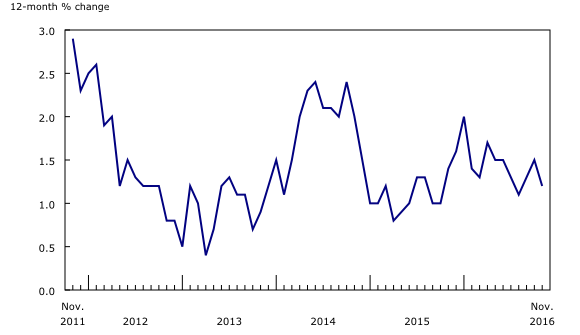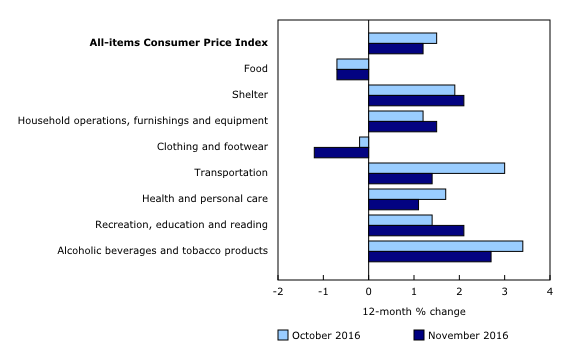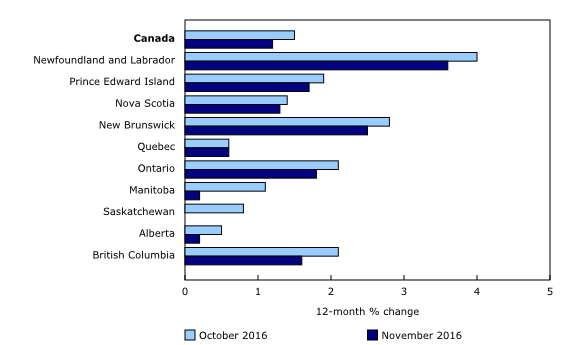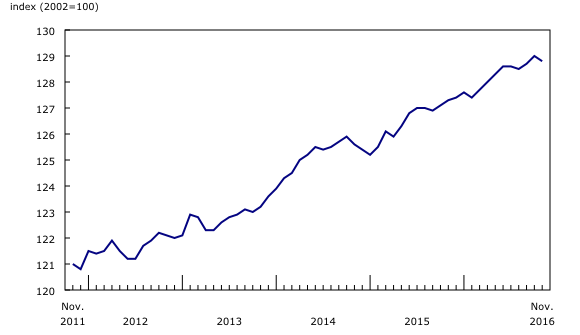Consumer Price Index, November 2016
Archived Content
Information identified as archived is provided for reference, research or recordkeeping purposes. It is not subject to the Government of Canada Web Standards and has not been altered or updated since it was archived. Please "contact us" to request a format other than those available.
Released: 2016-12-22
November 2016
1.2% 
(12-month change)
The Consumer Price Index (CPI) rose 1.2% on a year-over-year basis in November, following a 1.5% gain in October.
12-month change in the major components
Prices were up in six of the eight major components in the 12 months to November, with the shelter and transportation indexes contributing the most to the year-over-year rise in the CPI. The food index and the clothing and footwear index declined on a year-over-year basis.
The transportation index rose 1.4% year over year in November, following a 3.0% gain in October. This deceleration was led by gasoline prices, which declined 1.7% year over year in November after increasing 2.5% in October. The purchase of passenger vehicles index rose less year over year in November (+3.0%) than in October (+4.4%), but remained the main upward contributor to the 12-month change in the transportation index.
The clothing and footwear index was down 1.2% in the 12 months to November, led by a 6.5% price decline in children's clothing. The jewellery index posted its largest decline since April 1997, down 3.0% in the 12 months to November, after rising 4.0% in October.
Food prices were down 0.7% on a year-over-year basis in November, matching the decline in October. Prices for food purchased from stores declined 2.0% in the 12 months to November, with the fresh vegetables, meat, and fresh fruit indexes contributing the most to the decline. In contrast, the fish, seafood and other marine products index and the non-alcoholic beverages index posted gains in the 12 months to November. Prices for food purchased from restaurants were up 2.5% in the 12 months to November, following a 2.6% increase in October.
The shelter index rose 2.1% on a year-over-year basis in November. Homeowners' replacement cost contributed the most to this gain, rising 4.4% in the 12 months to November. Electricity prices remained a principal upward contributor to the 12-month change in the shelter index, despite a deceleration in price growth, up 3.5% in November, following a 5.3% increase in October. The natural gas index (-0.2%) recorded its smallest year-over-year decline since an increase in March 2015.
12-month change in the provinces
In eight provinces, consumer prices rose less year over year in November than in October. In Quebec, on a year-over-year basis, the growth in consumer prices in November matched that of October, while in Saskatchewan, consumer prices posted no change in the 12 months to November.
In Ontario, the CPI increased 1.8% year over year in November, following a 2.1% gain in October. The electricity index contributed to this deceleration, rising 11.2% in the 12 months to November, after increasing 15.2% in October. The furniture index rose 0.3% year over year in November, following a 1.8% gain in October. Meanwhile, the traveller accommodation index rose 7.9% in November, after increasing 2.1% in October.
The CPI in Quebec was up 0.6% on a year-over-year basis in November, matching the gain in October. The gasoline index increased 0.1% in November, after a 2.3% gain in October. Prices for fish, seafood and other marine products rose more year over year in November than in October. Additionally, the fresh fruit index experienced a turnaround, increasing 1.1% in the 12 months to November, after declining 6.0% in October.
In Saskatchewan, the CPI posted no change on a year-over-year basis in November, after rising 0.8% in October. The gasoline index (-11.6%) and the women's clothing index (-3.9%) declined in the 12 months to November. At the same time, the furniture index (+11.4%) in Saskatchewan posted the largest gain among the provinces.
Seasonally adjusted monthly Consumer Price Index decreases
On a seasonally adjusted monthly basis, the CPI declined 0.2% in November, after rising 0.2% in October.
In November, five major components declined on a seasonally adjusted monthly basis, while two increased. The food index was unchanged.
On a seasonally adjusted monthly basis in November, the transportation index (-0.6%) posted the largest decline, while the recreation, education and reading index (+0.4%) recorded the largest gain.
Bank of Canada's preferred measures of core inflation
Since 2001, the Bank of Canada's main measure of core inflation has been "core" consumer price index (CPIX) inflation, which excludes eight of the most volatile components of the CPI and adjusts the remainder for the effect of changes in indirect taxes.
Following a review of a wide selection of measures of core inflation in 2015, in the context of its most recent renewal of the inflation-control target, the Bank chose three preferred measures of core inflation:
(i) a measure based on a trimmed mean (CPI-trim);
(ii) a measure based on the weighted median (CPI-median);
(iii) a measure based on the common component (CPI-common).
More information on the Bank's selection of these measures can be found in the general information document. A detailed description of the methodologies of the Bank of Canada's preferred measures of core inflation can be found in the methodology document, while a summary of the methodologies follows.
Beginning with the November 2016 reference month, the three preferred measures will be computed and published by Statistics Canada.
In contrast to CPIX, the three preferred measures of core inflation do not rest on a predefined exclusion of volatile components.
All three measures use historical series, going back to 1989, of consumer price indexes based on a 55-component disaggregation of the CPI basket. These series are available on a monthly basis and adjusted to remove the effect of changes in indirect taxes. For CPI-trim and CPI-median, the series are also seasonally adjusted.
To compute CPI-trim, components are ranked by monthly inflation rates and CPI basket weights. The components that account for the 20% lowest and the 20% highest inflation rates are excluded. The monthly trimmed inflation rate is the arithmetic weighted average of the monthly inflation rates of the components that account for the remaining 60% of the basket weights in the middle of the distribution. The published CPI-trim inflation rate is an annual inflation rate. It represents the cumulative monthly trimmed inflation rate for the 12-month period ending in the current month.
The process to compute the CPI-median is similar. Components are ranked by monthly inflation rates and CPI basket weights. The monthly CPI-median is the first inflation rate such that the cumulative weight equals to or exceeds 50% of the total CPI basket. The CPI-median inflation rate published is an annual inflation rate. It represents the cumulative monthly median inflation rate for the 12-month period ending in the current month.
In addition to the 55 components the other measures use, the CPI-common uses the historical series of the all-items CPI, also adjusted to remove the effect of changes in indirect taxes. As opposed to CPI-trim and CPI-median, CPI-common uses year-over-year movements. Therefore, the index series used are not seasonally adjusted when calculating the CPI-common. This measure is based on a factor model, which essentially identifies a common source that best explains the variation in the 55 components over the entire historical series.
The CPI-common is defined as the predicted value obtained from a linear regression of the year-over-year change in the all-items CPI excluding the effect of changes in indirect taxes on an intercept and on the common source identified by the factor model. It is important to note that this process is performed monthly using the entire available historical data, so the values of the common source may change from one month to another.
Table 4 in The Daily will report every month each of the preferred measures of core inflation. Given the use of seasonally adjusted data for the CPI-trim and the CPI-median, and the nature of the technique used to compute the CPI-common, all three measures are subject to revision.
Note to readers
At the request of the Bank of Canada, Statistics Canada produces and publishes the Bank's three preferred measures of core inflation: CPI-trim (trimmed mean), CPI-median (weighted median), and CPI-common (common component). As of the Consumer Price Index (CPI) release on December 22, 2016, the following changes were implemented:
- The analysis section of The Daily titled "Bank of Canada's core index" has been removed.
- Within The Daily tables, the row titled "Bank of Canada's core index" has been deleted from Table 1 and Table 3.
- A new table (Table 4) on recent data for the Bank of Canada's preferred measures of core inflation has been introduced in The Daily.
- A new CANSIM table (326-0023), "Consumer Price Index (CPI) statistics, measures of core inflation – Bank of Canada definitions," displays the results of the following measures: CPI-common (common component), CPI-median (weighted median), and CPI-trim (trimmed mean).
- The existing measure of core inflation continues to be produced and published by Statistics Canada, but is no longer referred to as the Bank of Canada's core index (CPIX). Instead, it is called the "Consumer Price Index (CPI), all-items excluding eight of the most volatile components as defined by the Bank of Canada and excluding the effect of changes in indirect taxes."
Upcoming basket update
Every two years, the expenditure weights for the basket of goods and services used in the calculation of the CPI are updated based on new estimates from the Survey of Household Spending (SHS). On February 24, 2017, with the release of the January 2017 CPI, these expenditure weights will be updated with the household expenditure weights based on the 2015 SHS. This new weighting pattern will replace the current expenditure weights, which are based on the 2013 SHS.
The index base period, for which the CPI equals 100, will remain 2002.
There will be changes to the CANSIM tables as two published series will be terminated: "Rental of digital media" and "Other home entertainment equipment, parts and services." As a result, their assigned vectors within CANSIM tables 326-0020, 326-0021 and 326-0031 will no longer be updated.
Seasonal adjustment
A seasonally adjusted series is one from which seasonal movements have been eliminated. Users employing CPI data for indexation purposes are advised to use the unadjusted indexes. For more information on seasonal adjustment, see Seasonally adjusted data – Frequently asked questions.
Next release
The CPI for December 2016 will be released on January 20, 2017.
Products
The November 2016 issue of The Consumer Price Index, Vol. 95, no. 11 (62-001-X), is now available.
More information about the concepts and use of the Consumer Price Index (CPI) is available in The Canadian Consumer Price Index Reference Paper (62-553-X).
For information on the history of the CPI in Canada, consult the publication Exploring the First Century of Canada's Consumer Price Index (62-604-X).
Two videos, "An Overview of Canada's Consumer Price Index (CPI)" and "The Consumer Price Index and Your Experience of Price Change," are available on Statistics Canada's YouTube channel.
Contact information
For more information, or to enquire about the concepts, methods or data quality of this release, contact us (toll-free 1-800-263-1136; 514-283-8300; STATCAN.infostats-infostats.STATCAN@canada.ca) or Media Relations (613-951-4636; STATCAN.mediahotline-ligneinfomedias.STATCAN@canada.ca).
- Date modified:





